Trends in Locally Balanced Energy Systems without the Use of Fossil Fuels: A Review
Abstract
:1. Introduction
- A net-zero (ecological) transformation, related to managing carbon dioxide emissions and gradually moving away from fossil fuels, building a circular economy, building a zero-emission supply chain, implementing carbon capture utilization and storage (CCUS) systems [1], and introducing carbon taxes;
- An energy transformation involving the diversification of energy generation systems using renewable energy sources (RES), improving energy efficiency while reducing energy losses and saving energy consumption, integrating smart energy grids and effective and competitive local energy markets;
- A digital transformation related to the development of strategies and management systems, the digital activation and creation of digital platforms enabling the collection, and the analysis and use of data for the development of business models.
- Combined heat and power CHP (cogeneration);
- Renewable energy sources (photovoltaic systems, wind power plants, and hydro power plants);
- Hybrid power systems;
- Fuel cells;
- Reciprocating engines;
- Stirling engines;
- Energy storage.
- Justification of the concept of local energy balancing in new energy systems without the use of fossil fuels, based on the guidelines and trends contained in formal documents and the literature;
- Organizing the nomenclature related to the description of locally balanced energy systems without the use of fossil fuels;
- Presentation of the state of knowledge (based on a thorough literature review) in the field of theoretical/laboratory proposals/implementations in the field of locally balanced energy areas without the use of fossil fuels;
- Discussion of the issue of electrical protection in new energy systems;
- Critical assessment and indication of directions for future scientific and research work in the field of development of locally sustainable systems without the use of fossil fuels.
2. Energy Self-Sufficiency and Local Energy Balancing
3. The Concept of Local Smart Grids Based on Innovative Market Mechanisms
- Optimization, understood as the search for the best means, method, and technical activity through operations on mathematical models;
- Modernization of the system through actions on models and searching for novelties;
- Innovation, i.e., inventing and implementing a new measure, system or technical activity.
- The energy supply subsystem—a multi-energy, centralized system including wind, solar and water power plants, and pumped storage;
- Energy use subsystem—an effectively managed distributed generation system (photovoltaic (PV) + heat pumps), low-emission transport, cooperation with the power grid (V2G—vehicle to grid), the introduction of heat recovery, CO2 capture, and storage and utilization systems (CCUS) in industrial areas;
- The energy transmission subsystem—the introduction of innovative market solutions.
- Combinatorial, in which the following can be distinguished:
- Exact optimization (branch and bound, and dynamic programming);
- Approximation (including metaheuristic algorithms and random search).
- Continuous, including the following:
- Linear programming (simplex method and interior-point method);
- Non-linear programming (local and global search).
4. Review of Technical Solutions of Locally Balanced Energy Systems
4.1. Self-Sufficient Systems Based on PV and Energy Storage
4.2. Overview of Locally Balanced Systems without Fossil Fuels (Communities and Cooperatives)
- Case study;
- Examination of the energy state as a starting point;
- Inventory of the energy potential of the area;
- Actual generation of alternative solutions based on previous stages;
- Evaluation and selection of the best solution.
- Flexible production of renewable energy (production of “on demand” biogas from anaerobic digestion and its storage at home to ensure supplies to generate balancing power [109]);
- Use of DSM mechanisms with load shifting;
- Reduction in energy consumption;
- Energy storage;
- Increasing network capacity.
5. Challenges in the Field of Electrical Protections in Networks with Local Energy Sources
- At least a simple separation between the AC side and the DC side of the PV circuit is provided by the inverter;
- At least a simple separation between the RCD and the inverter (by a transformer) in the PV circuit is provided;
- Or, the construction of the PV inverter ensures that the RCD of type B (B+) is not necessary—this condition should be provided by the manufacturer of the PV inverter.
- Type B (B+) RCDs;
- Or, type A (type F) RCDs along with an additional device which detects a DC component higher than 6 mA—this is a residual direct current-directing device (RDC-DD) specified by the standard IEC 62955 [139].
- Fundamental: usually 50 Hz/60 Hz with 50% content;
- High-frequency: 1000 Hz with 50% content.
6. Discussion
7. Conclusions
Author Contributions
Funding
Data Availability Statement
Conflicts of Interest
References
- Holechek, J.L.; Geli, H.M.E.; Sawalhah, M.N.; Valdez, R.A. Global Assessment: Can Renewable Energy Replace Fossil Fuels by 2050? Sustainability 2022, 14, 4792. [Google Scholar] [CrossRef]
- Masson-Delmotte, V.; Zhai, P.; Pörtner, H.-O.; Roberts, D.; Skea, J.; Shukla, P.R.; Pirani, A.; Moufouma-Okia, W.; Péan, C.; Pidcock, R.; et al. Global Warming of 1.5 °C; International Panel on Climate Change: Geneva, Switzerland, 2018. [Google Scholar]
- Ripple, W.J.; Wolf, C.; Newsome, T.W.; Gregg, J.W.; Lenton, M.; Barnard, P.; Moomaw, W.R. World scientists warning of climate emergency 2021. BioScience 2021, 71, 894–898. [Google Scholar] [CrossRef]
- World Population Clock. Available online: https://www.worldometers.info/world-population/ (accessed on 8 April 2023).
- Berahab, R. Global Trends in the Energy Sector and Their Implication on Energy Security in NATO’s Southern Neighbourhood; Elcano Royal Institute: Madrid, Spain, 8 September 2020. [Google Scholar]
- World Energy Transitions Outlook 2022 Executive Summary and Introduction. Available online: https://www.irena.org/Digital-Report/World-Energy-Transitions-Outlook-2022 (accessed on 10 April 2023).
- Koirala, B.P.; Koliou, E.; Friege, J.; Hakvoort, R.A.; Herder, P.M. Energetic communities for community energy: A review of key issues and trends shaping integrated community energy systems. Renew. Sustain. Energy Rev. 2016, 56, 722–744. [Google Scholar] [CrossRef] [Green Version]
- Hu, H.; Sun, F.; Guo, W.; Pan, L. Net-Zero Intelligent Energy System: Road to a Successful Carbon Neutral Future. In Proceedings of the 12th International Conference on Power, Energy and Electrical Engineering (CPEEE), Shiga, Japan, 25–27 February 2022; pp. 285–291. [Google Scholar] [CrossRef]
- Shayeghi, H.; Shahryari, E.; Moradzadeh, M.; Siano, P. A Survey on Microgrid Energy Management Considering Flexible Energy Sources. Energies 2019, 12, 2156. [Google Scholar] [CrossRef] [Green Version]
- Sheikhahmadi, P.; Bahramara, P.S.; Shahrokhi, S.; Chicco, G.; Mazza, A.; Catalão, J.P.S. Modeling Local Energy Market for Energy Management of Multi-Microgrids. In Proceedings of the 55th International Universities Power Engineering Conference (UPEC), Turin, Italy, 1–4 September 2020; pp. 1–6. [Google Scholar] [CrossRef]
- El-Khattam, W.; Salama, M.M. Distributed generation technologies, definitions and benefits. Electr. Power Syst. Res. 2004, 71, 119–128. [Google Scholar] [CrossRef]
- Pepermans, G.; Driesen, J.; Haeseldonckx, D.; Belmans, R.; D’haeseleer, W. Distributed generation: Definition, benefits and issues. Energy Policy 2005, 33, 787–798. [Google Scholar] [CrossRef]
- Battula, A.R.; Vuddanti, S.; Salkuti, S.R. Review of Energy Management System Approaches in Microgrids. Energies 2021, 14, 5459. [Google Scholar] [CrossRef]
- Du, Y.; Li, F. Integrating a Multi-microgrid System into Real-time Balancing Market: Problem Formulation and Solution Technique. In Proceedings of the 2018 IEEE Power & Energy Society General Meeting (PESGM), Portland, OR, USA, 5–10 August 2018; pp. 1–5. [Google Scholar] [CrossRef]
- European Union. Consolidated Version of the Treaty on the Functioning of the European Union. 2012. Available online: https://eur-lex.europa.eu/legal-content/EN/TXT/?uri=celex%3A12012E%2FTXT (accessed on 9 April 2023).
- European Commission. ‘Fit for 55’ Delivering the EU’s 2030 Climate Target on the Way to Climate Neutrality; Communication from the Commission to the European Parliament, the European Council, the Council, the European Economic and Social Committee and the Committee of the Regions Empty; European Commision: Brussels, Berlgium, 14 July 2021. [Google Scholar]
- European Union. Directive (EU) 2019/944 of the European Parliament and of the Council of 5 June 2019 on common rules for the internal market for electricity and amending directive 2012/27/EU. Off. J. Eur. Union. 2019, 158, 125–199. [Google Scholar]
- Cambridge Dictionary: Self-Sufficiency. Available online: https://dictionary.cambridge.org/dictionary/english/self-sufficiency (accessed on 9 April 2023).
- Abegg, B. Energy self-sufficient regions in the European Alps. Mt. Res. Dev. 2011, 31, 367–371. [Google Scholar] [CrossRef]
- Hirschl, B.; Aretz, A.; Prahl, A.; Böther, T.; Heinbach, K.; Pick, D.; Funcke, S. Kommunale Wertschöpfung durch Erneuerbare Energien. Schriftenreihe des IWÖ 196/10; Institut für Ökologische Wirtschaftsforschung (IWÖ): Berlin, Germany, 2010. [Google Scholar]
- Attemene, N.S.; Agbli, K.S.; Fofana, S.; Hessel, D. Optimal sizing of a wind, fuel cell, electrolyzer, battery and supercapacitor system for off-grid applications. Int. J. Hydrogen Energy 2020, 45, 5512–5525. [Google Scholar] [CrossRef]
- Popławski, T. Conditioning and principles of functioning of energy self-sufficient areas—Selected aspects. Nowa Energ. 2019, 3, 6–11. (In Polish) [Google Scholar]
- Schmidt, J.; Schönhart, M.; Biberacher, M.; Guggenbergert, T.; Hausl, S.; Kaltg, G.; Leduc, S.; Schardinger, I.; Schmid, E. Regional energy autarky: Potentials, costs and consequences for an Austrian region. Energy Policy 2012, 47, 211–221. [Google Scholar] [CrossRef]
- Sołtysik, M.; Mucha-Kuś, K.; Rogus, R. Energy clusters in achieving the energy self-sufficiency of communes. Zesz. Nauk. Inst. Gospod. Surowcami Miner. I Energ. Pol. Akad. Nauk. 2018, 102, 301–312. (In Polish) [Google Scholar]
- European Union. Directive (EU) 2018/2001 of the European Parliament and of the Council of 11 Dec. 2018 on the promotion of the use of energy from renewable sources. Off. J. Eur. Union. 2018, 328, 82–209. [Google Scholar]
- Mutani, G.; Santantonio, S.; Brunetta, G.; Caldarice, O.; Demichela, M. An energy community for territorial resilience: Measurement of the risk of an energy supply blackout. Energy Build. 2021, 240, 110906. [Google Scholar] [CrossRef]
- Ollas, P.; Persson, J.; Markusson, C.; Alfadel, U. Impact of Battery Sizing on Self-Consumption, Self-Sufficiency and Peak Power Demand for a Low Energy Single-Family House with PV Production in Sweden. In Proceedings of the 2018 IEEE 7th World Conference on Photovoltaic Energy Conversion (WCPEC) (A Joint Conference of 45th IEEE PVSC, 28th PVSEC & 34th EU PVSEC), Waikoloa, HI, USA, 10–15 June 2018; pp. 618–623. [Google Scholar] [CrossRef]
- Luthander, R.; Widén, J.; Nilsson, D.; Palm, J. Photovoltaic self-consumption in buildings: A review. Appl. Energy 2015, 142, 80–94. [Google Scholar] [CrossRef] [Green Version]
- Hernández, J.C.; Sanchez-Sutil, F.; Muñoz Rodríguez, F.J.; Baier, C.R. Optimal sizing and management strategy for PV household-prosumers with self-consumption/sufficiency enhancement and provision of frequency containment reserve. Appl. Energy 2020, 277, 115529. [Google Scholar] [CrossRef]
- Hassan, Q.; Jaszczur, M.; Abdulateef, A.M.; Abdulateef, J.; Hasan, A.; Mohamad, A. An analysis of photovoltaic/supercapacitor energy system for improving self-consumption and self-sufficiency. Energy Rep. 2022, 8, 680–695. [Google Scholar] [CrossRef]
- Jaszczur, M.; Hassan, Q. An optimisation and sizing of photovoltaic system with supercapacitor for improving self-consumption. Appl. Energy 2020, 279, 115776. [Google Scholar] [CrossRef]
- Muñoz-Rodríguez, F.J.; Jiménez-Castillo, G.; de la Casa Hernández, J.; Peña, J.D.A. A new tool to analysing photovoltaic self-consumption systems with batteries. Renew. Energy 2021, 168, 1327–1343. [Google Scholar] [CrossRef]
- Ciocia, A.; Amato, A.; Di Leo, P.; Fichera, S.; Malgaroli, G.; Spertino, F.; Tzanova, S. Self-Consumption and Self-Sufficiency in Photovoltaic Systems: Effect of Grid Limitation and Storage Installation. Energies 2021, 14, 1591. [Google Scholar] [CrossRef]
- Cambridge Dictionary: Consumption. Available online: https://dictionary.cambridge.org/dictionary/english/consumption (accessed on 11 April 2023).
- Zepter, J.M.; Engelhardt, J.; Gabderakhmanova, T.; Marinelli, M. Re-Thinking the Definition of Self-Sufficiency in Systems with Energy Storage. In Proceedings of the 2022 International Conference on Smart Energy Systems and Technologies (SEST), Eindhoven, The Netherlands, 5–7 September 2022; pp. 1–6. [Google Scholar] [CrossRef]
- Oota, M.; Iwafune, Y.; Ooka, R. Estimation of Self-Sufficiency Rate in Detached Houses Using Home Energy Management System Data. Energies 2021, 14, 975. [Google Scholar] [CrossRef]
- Wanitschke, A.; Pieniak, N.; Schaller, F. Economic and environmental cost of self-sufficiency—Analysis of an urban micro grid. Energy Procedia 2017, 135, 445–451. [Google Scholar] [CrossRef]
- EU Commission Task Force for Smart Grids. Expert Group 1: Functionalities of Smart Grids and Smart Meters; European Commission: Brussels, Belgium, 22 June 2010. [Google Scholar]
- Bayindir, R.; Colak, I.; Fulli, G.; Demirtas, K. Smart grid technologies and applications. Renew. Sustain. Energy Rev. 2016, 66, 499–516. [Google Scholar] [CrossRef]
- Bieliński, K. Monitoring as an energy management supporting tool. Rynek Energii 2012, 6, 10–14. (In Polish) [Google Scholar]
- Attia, S. Net Zero Energy Buildings (NZEB): Concepts, Frameworks and Roadmap for Project Analysis and Implementation; Butterworth-Heinemann: Oxford, UK, 2018. [Google Scholar] [CrossRef]
- Moghaddasi, H.; Culp, C.; Vanegas, J. Net Zero Energy Communities: Integrated Power System, Building and Transport Sectors. Energies 2021, 14, 7065. [Google Scholar] [CrossRef]
- International Energy Agency (IEA). Net Zero by 2050: A Roadmap for the Global Energy Sector. May 2021. Available online: https://www.iea.org/reports/net-zero-by-2050 (accessed on 17 April 2023).
- Carlisle, N.; van Geet, O.; Pless, S. Definition of a ’Zero Net Energy’ Community; National Renewable Energy Lab. (NREL): Golden, CO, USA, 2009. [CrossRef] [Green Version]
- Peterson, K.; Torcellini, P.; Grant, R. A Common Definition for Zero Energy Buildings; Department of Energy (DOE): Washington, DC, USA, 2015.
- Santos, G.; Faia, R.; Pereira, H.; Pinto, T.; Vale, Z. Blockchain-based Local Electricity Market Solution. In Proceedings of the 2022 18th International Conference on the European Energy Market (EEM), Ljubljana, Slovenia, 13–15 September 2022; pp. 1–7. [Google Scholar] [CrossRef]
- Crespo-Vazquez, J.L.; Sanchez de la Nieta, A.A.; Gibescu, M. A decision-making framework encouraging local energy exchanges among smart buildings. In Proceedings of the 2019 International Conference on Smart Energy Systems and Technologies (SEST), Porto, Portugal, 9–11 September 2019; pp. 1–6. [Google Scholar] [CrossRef]
- Olek, B.; Wierzbowski, M. Local Energy Balancing and Ancillary Services in Low-Voltage Networks with Distributed Generation, Energy Storage, and Active Loads. IEEE Trans. Ind. Electron. 2015, 62, 2499–2508. [Google Scholar] [CrossRef]
- Melton, R.B. GridWise Transactive Energy Framework Ver. 1.1. No. PNNL-22946 Ver. 1.1; Pacific Northwest National Lab. (PNNL): Richland, WA, USA, 2019.
- Tejaswini, Y.; Jain, P. Transactive Energy Management of Solar Integrated Villages In India. In Proceedings of the 2021 IEEE 2nd International Conference on Electrical Power and Energy Systems (ICEPES), Bhopal, India, 10–11 December 2021; pp. 1–6. [Google Scholar] [CrossRef]
- El-Batawy, S.A.; Morsi, W.G. Integration of Prosumers with Battery Storage and Electric Vehicles via Transactive Energy. IEEE Trans. Power Deliv. 2022, 37, 383–394. [Google Scholar] [CrossRef]
- Hammerstrom, D.J.; Widergren, S.E.; Irwin, C. Evaluating Transactive Systems: Historical and Current U.S. DOE Research and Development Activities. IEEE Electrif. Mag. 2016, 4, 30–36. [Google Scholar] [CrossRef]
- Melton, R. Pacific Northwest Smart Grid Demonstration Project Technology Performance Report Volume 1: Technology Performance; Pacific Northwest National Lab. (PNNL): Richland, WA, USA, 2019. [CrossRef]
- Smart Stuff: IQ of Northwest Power Grid Raised, Energy Saved. Available online: https://www.pnnl.gov/news/release.aspx?id=4210 (accessed on 2 May 2023).
- Widergren, S.E.; Subbarao, K.; Fuller, J.C.; Chassin, D.P.; Somani, A.; Marinovici, M.C.; Hammerstrom, J.L. AEP Ohio gridSMART Demonstration Project Real-Time Pricing Demonstration Analysis; Pacific Northwest National Lab. (PNNL): Richland, WA, USA, 2014. [CrossRef] [Green Version]
- AEP gridSMART Demonstration Project. Available online: https://www.pnnl.gov/projects/transactive-systems-program/aep-gridsmart-demonstration-project (accessed on 2 May 2023).
- Power MatcherSuite Transactive Energy. Available online: https://flexiblepower.github.io/ (accessed on 2 May 2023).
- Saboori, H.; Mohammadi, M.; Taghe, R. Virtual Power Plant (VPP), Definition, Concept, Components and Types. In Proceedings of the 2011 Asia-Pacific Power and Energy Engineering Conference, Wuhan, China, 25–28 March 2011; pp. 1–4. [Google Scholar] [CrossRef]
- Liang, Z.; Alsafasfeh, Q.; Jin, T.; Pourbabak, H.; Su, W. Risk-Constrained Optimal Energy Management for Virtual Power Plants Considering Correlated Demand Response. IEEE Trans. Smart Grid 2017, 10, 1577–1587. [Google Scholar] [CrossRef]
- Ullah, Z.; Hassanin, H. Modeling, optimization, and analysis of a virtual power plant demand response mechanism for the internal electricity market considering the uncertainty of renewable energy sources. Energies 2022, 15, 5296. [Google Scholar] [CrossRef]
- Kasaei, M.J.; Gandomkar, M.; Nikoukar, J. Optimal management of renewable energy sources by virtual power plant. Renew. Energy 2017, 114, 1180–1188. [Google Scholar] [CrossRef]
- Zepter, J.M.; Lüth, A.; Crespo del Granado, P.; Egging, R. Prosumer integration in wholesale electricity markets: Synergies of peer-to-peer trade and residential storage. Energy Build. 2019, 184, 163–176. [Google Scholar] [CrossRef]
- Sadeghi, S.; Jahangir, H.; Vatandoust, B.; Golkar, M.A.; Ahmadian, A.; Elkamel, A. Optimal bidding strategy of a virtual power plant in day-ahead energy and frequency regulation markets: A deep learning-based approach. Int. J. Electr. Power Energy Syst. 2021, 127, 106646. [Google Scholar] [CrossRef]
- Hooshmand, R.-A.; Nosratabadi, S.M.; Gholipour, E. Event-based scheduling of industrial technical virtual power plant considering wind and market prices stochastic behaviors—A case study in Iran. J. Clean. Prod. 2018, 172, 1748–1764. [Google Scholar] [CrossRef]
- Chen, G.; Li, J. A fully distributed ADMM-based dispatch approach for virtual power plant problems. Appl. Math. Model. 2018, 58, 300–312. [Google Scholar] [CrossRef]
- Shabanzadeh, M.; Sheikh-El-Eslami, M.-K.; Haghifam, M.-R. The design of a risk-hedging tool for virtual power plants via robust optimization approach. Appl. Energy 2015, 155, 766–777. [Google Scholar] [CrossRef]
- Gougheri, S.S.; Dehghani, M.; Nikoofard, A.; Jahangir, H.; Golkar, M.A. Economic assessment of multi-operator virtual power plants in electricity market: A game theory-based approach. Sustain. Energy Technol. Assess. 2022, 53, 102733. [Google Scholar] [CrossRef]
- Ullah, Z.; Hassanin, H.; Cugley, J.; Alawi, M.A. Planning, Operation, and Design of Market-Based Virtual Power Plant Considering Uncertainty. Energies 2022, 15, 7290. [Google Scholar] [CrossRef]
- Ju, L.; Tan, Q.; Lu, Y.; Tan, Z.; Zhang, Y.; Tan, Q. A CVaR-robust-based multi-objective optimization model and three-stage solution algorithm for a virtual power plant considering uncertainties and carbon emission allowances. Int. J. Electr. Power Energy Syst. 2019, 107, 628–643. [Google Scholar] [CrossRef]
- Ahmadian, A.; Ponnambalam, K.; Almansoori, A.; Elkamel, A. Optimal Management of a Virtual Power Plant Consisting of Renewable Energy Resources and Electric Vehicles Using Mixed-Integer Linear Programming and Deep Learning. Energies 2023, 16, 1000. [Google Scholar] [CrossRef]
- Abdulkader, R.; Ghanimi, H.M.A.; Dadheech, P.; Alharbi, M.; El-Shafai, W.; Fouda, M.M.; Aly, M.H.; Swaminathan, D.; Sengan, S. Soft Computing in Smart Grid with Decentralized Generation and Renewable Energy Storage System Planning. Energies 2023, 16, 2655. [Google Scholar] [CrossRef]
- Pijarski, P.; Kacejko, P.; Miller, P. Advanced Optimisation and Forecasting Methods in Power Engineering—Introduction to the Special Issue. Energies 2023, 16, 2804. [Google Scholar] [CrossRef]
- Ahmad, N.; Ghadi, Y.; Adnan, M.; Ali, M. Load Forecasting Techniques for Power System: Research Challenges and Survey. IEEE Access 2022, 10, 71054–71090. [Google Scholar] [CrossRef]
- Alnaser, S.W.; Althaher, S.Z.; Long, C.; Zhou, Y.; Wu, J.; Hamdan, R. Transition towards solar Photovoltaic Self-Consumption policies with Batteries: From the perspective of distribution networks. Appl. Energy 2021, 304, 117859. [Google Scholar] [CrossRef]
- Leo, P.D.; Spertino, F.; Fichera, S.; Malgaroli, G.; and Ratclif, A. Improvement of Self-Sufficiency for an Innovative Nearly Zero Energy Building by Photovoltaic Generators. In Proceedings of the 2019 IEEE Milan PowerTech, Milan, Italy, 23–27 June 2019; pp. 1–6. [Google Scholar] [CrossRef]
- Hassan, Q.; Pawela, B.; Hasan, A.; Jaszczur, M. Optimization of Large-Scale Battery Storage Capacity in Conjunction with Photovoltaic Systems for Maximum Self-Sustainability. Energies 2022, 15, 3845. [Google Scholar] [CrossRef]
- Díaz, N.L.; Wu, D.; Dragičević, T.J.; Vásquez, C.; Guerrero, J.M. Stored energy balance for distributed PV-based active generators in an AC microgrid. In Proceedings of the 2015 IEEE Power & Energy Society General Meeting, Denver, CO, USA, 26–30 July 2015; pp. 1–5. [Google Scholar] [CrossRef] [Green Version]
- Smara, Z.; Laldji, A.; Ferkous, A.; Tali, M.; Mahrane, A.; Dizene, R. Evaluation of the self sufficiency of a home powered by a PV–Wind system. In Proceedings of the 2018 International Conference on Applied Smart Systems (ICASS), Medea, Algeria, 24–25 November 2018; pp. 1–7. [Google Scholar] [CrossRef]
- Albouys-Perrois, J.; Sabouret, N.; Haradji, Y.; Schumann, M.; Charrier, B.; Reynaud, Q.; Inard, C. Multi-agent simulation of collective self-consumption: Impacts of storage systems and large-scale energy exchanges. Energy Build. 2022, 254, 111543. [Google Scholar] [CrossRef]
- Hassan, Q. Evaluation and optimization of off-grid and on-grid photovoltaic power system for typical household electrification. Renew. Energy 2021, 164, 375–390. [Google Scholar] [CrossRef]
- Al-Saadi, M.; Al-Greer, M.; Short, M. Strategies for Controlling Microgrid Networks with Energy Storage Systems: A Review. Energies 2021, 14, 7234. [Google Scholar] [CrossRef]
- Fahmi, M.I.; Rajkumar, R.; Arelhi, R.; Rajkumar, R.; Isa, D. The performance of a solar PV system using supercapacitor and varying loads. In Proceedings of the 2014 IEEE Student Conference on Research and Development, Penang, Malaysia, 16–17 December 2014; pp. 1–5. [Google Scholar] [CrossRef]
- Ghaib, K.; Ben-Fares, F.Z. A design methodology of stand-alone photovoltaic power systems for rural electrification. Energy Convers. Manag. 2017, 148, 1127–1141. [Google Scholar] [CrossRef]
- Eroglu, A.; Dey, T.; Dey, K.; Whelan, G. Supercapacitor implementation for PV power generation system and integration. In Proceedings of the 2018 International Applied Computational Electromagnetics Society Symposium (ACES), Denver, CO, USA, 25–29 March 2018; Volume 33. [Google Scholar]
- Jing, W.; Lai, C.H.; Wong, W.S.H.; Wong, M.L.D. A comprehensive study of battery-supercapacitor hybrid energy storage system for stand-alone PV power system in rural electrification. Appl. Energy 2018, 224, 340–356. [Google Scholar] [CrossRef]
- Huang, A.Q.; Baliga, J. FREEDM System: Role of power electronics and power semiconductors in Developing an energy internet. In Proceedings of the 2009 21st International Symposium on Power Semiconductor Devices & IC’s, Barcelona, Spain, 14–18 June 2009; pp. 9–12. [Google Scholar] [CrossRef]
- Hussain, H.M.; Narayanan, A.; Nardelli, P.H.J.; Yang, Y. What is Energy Internet? Concepts, Technologies, and Future Directions. IEEE Access 2020, 8, 183127–183145. [Google Scholar] [CrossRef]
- Rakas, S.V.B. Energy Internet: Architecture, Emerging Technologies, and Security Issues. In Cyber Security of Industrial Control Systems in the Future Internet Environment; IGI Global: Hershey, PA, USA, 2020; pp. 248–266. [Google Scholar] [CrossRef]
- Han, X.; Yang, F.; Bai, C.; Xie, G.; Ren, G.; Hua, H.; Cao, J. An Open Energy Routing Network for Low-Voltage Distribution Power Grid. In Proceedings of the 2017 IEEE International Conference on Energy Internet (ICEI), Beijing, China, 17–21 April 2017; pp. 320–325. [Google Scholar] [CrossRef]
- Wang, K.; Liu, X.; Zhao, L.; Zhou, Y.; Xu, D. Research on Structure and Energy Management Strategy of Household Energy Router Based on Hybrid Energy Storage. In Proceedings of the 2019 IEEE Power & Energy Society Innovative Smart Grid Technologies Conference (ISGT), Washington, DC, USA, 18–21 February 2019; pp. 1–5. [Google Scholar] [CrossRef]
- Canale, L.; Di Fazio, A.R.; Russo, M.; Frattolillo, A.; Dell’Isola, M. An Overview on Functional Integration of Hybrid Renewable Energy Systems in Multi-Energy Buildings. Energies 2021, 14, 1078. [Google Scholar] [CrossRef]
- Lokar, J.; Virtič, P. The potential for integration of hydrogen for complete energy self-sufficiency in residential buildings with photovoltaic and battery storage systems. Int. J. Hydrogen Energy 2020, 45, 34566–34578. [Google Scholar] [CrossRef]
- Hassan, Q. Optimisation of solar-hydrogen power system for household applications. Int. J. Hydrogen Energy 2020, 45, 33111–33127. [Google Scholar] [CrossRef]
- Cai, G.; Chen, C.; Kong, L.; Peng, L. Control of hybrid system of wind/hydrogen/fuel cell/supercapacitor. Diangong Jishu Xuebao/Trans. China Electrotech. Soc. 2017, 32, 84–94. [Google Scholar] [CrossRef]
- Möller, C.; Kuhnke, K.; Reckzügel, M.; Pfisterer, H.-J.; Rosenberger, S. Energy storage potential in the Northern German region Osnabrück-Steinfurt. In Proceedings of the 2016 International Energy and Sustainability Conference (IESC), Cologne, Germany, 30 June–1 July 2016; pp. 1–7. [Google Scholar] [CrossRef]
- Pestisha, A.; Gabnai, Z.; Chalgynbayeva, A.; Lengyel, P.; Bai, A. On-Farm Renewable Energy Systems: A Systematic Review. Energies 2023, 16, 862. [Google Scholar] [CrossRef]
- Ramos-Suárez, J.L.; Ritter, A.; González, J.M.; Pérez, A.C. Biogas from animal manure: A sustainable energy opportunity in the Canary Islands. Renew. Sustain. Energy Rev. 2019, 104, 137–150. [Google Scholar] [CrossRef]
- Villarroel-Schneider, J.; Höglund-Isaksson, L.; Mainali, B.; Martí-Herrero, J.; Cardozo, E.; Malmquist, A.; Martin, A. Energy self-sufficiency and greenhouse gas emission reductions in Latin American dairy farms through massive implementation of biogas-based solutions. Energy Convers. Manag. 2022, 261, 115670. [Google Scholar] [CrossRef]
- Augustyn, G.; Mikulik, J.; Rumin, R.; Szyba, M. Energy Self-Sufficient Livestock Farm as the Example of Agricultural Hybrid Off-Grid System. Energies 2021, 14, 7041. [Google Scholar] [CrossRef]
- Sharma, M.; Agarwal, R.B. Energy Management of village towards self-sufficiency. In Proceedings of the 2009 International Conference on Power Systems, Kharagpur, India, 27–29 December 2009; pp. 1–5. [Google Scholar] [CrossRef]
- Arcos-Vargas, A.; Gomez-Exposito, A.; Gutierrez-Garcia, F. Self-sufficient renewable energy supply in urban areas: Application to the city of Seville. Sustain. Cities Soc. 2015, 46, 101450. [Google Scholar] [CrossRef]
- Doroudchi, E.; Khajeh, H.; Laaksonen, H. Increasing Self-Sufficiency of Energy Community by Common Thermal Energy Storage. IEEE Access 2022, 10, 85106–85113. [Google Scholar] [CrossRef]
- Roberts, M.B.; Bruce, A.; MacGill, I. Impact of shared battery energy storage systems on photovoltaic self-consumption and electricity bills in apartment buildings. Appl. Energy 2019, 245, 78–95. [Google Scholar] [CrossRef]
- Fournely, C.; Bird, N.; Medved, T.; Gubina, A.F.; Lakić, E.; Stojanović, B. Analysis of the Concepts of Self-Sufficiency of Renewable Energy Sources of the Local Energy Community of Luče, Slovenia. In Proceedings of the 2022 18th International Conference on the European Energy Market (EEM), Ljubljana, Slovenia, 13–15 September 2022. [Google Scholar] [CrossRef]
- Pilot Site Luče. Available online: https://main.compile-project.eu/sites/pilot-site-luce/ (accessed on 1 May 2023).
- Jereb, B.; Artač, G. Energy Community Luče. In Proceedings of the 2019 16th International Conference on the European Energy Market (EEM), Ljubljana, Slovenia, 18–20 September 2019; pp. 1–4. [Google Scholar] [CrossRef]
- Jansen, S.; Mohammadi, S.; Bokel, R. Developing a locally balanced energy system for an existing neighbourhood, using the ‘Smart Urban Isle’approach. Sustain. Cities Soc. 2021, 64, 102496. [Google Scholar] [CrossRef]
- Pierie, F.; van Someren, C.E.J.; Kruse, S.N.M.; Laugs, G.A.H.; Benders, R.M.J.; Moll, H.C. Local Balancing of the Electricity Grid in a Renewable Municipality; Analyzing the Effectiveness and Cost of Decentralized Load Balancing Looking at Multiple Combinations of Technologies. Energies 2021, 14, 4926. [Google Scholar] [CrossRef]
- Berglund, M.; Börjesson, P. Assessment of energy performance in the life-cycle of biogas production. Biomass Bioenergy 2006, 30, 254–266. [Google Scholar] [CrossRef]
- Cambridge Dictionary: Blockchain. Available online: https://dictionary.cambridge.org/dictionary/english/blockchain (accessed on 5 May 2023).
- Swain, A.; Salkuti, S.R.; Swain, K. An Optimized and Decentralized Energy Provision System for Smart Cities. Energies 2021, 14, 1451. [Google Scholar] [CrossRef]
- Zamfirescu, A.; Șuhan, C.; Golovanov, N. Blockchain Technology Application in Improving of Energy Efficiency and Power Quality. In Proceedings of the 54th International Universities Power Engineering Conference (UPEC), Bucharest, Romania, 3–6 September 2019. [Google Scholar]
- Li, Z.; Bahramirad, S.; Paaso, A.; Yan, M.; Shahidehpour, M. Blockchain for decentralized transactive energy management system in networked micro grids. Electr. J. 2019, 32, 58–72. [Google Scholar] [CrossRef]
- Shao, W.; Xu, W.; Xu, Z.; Liu, B.; Zou, H. A Grid Connection Mechanism of Large-scale Distributed Energy Resources based on Blockchain. In Proceedings of the Chinese Control Conference (CCC), Guangzhou, China, 27–30 July 2019. [Google Scholar]
- Adeyemi, A.; Yan, M.; Shahidehpour, M.; Botero, C.; Guerra, A.V.; Gurung, N.; Zhang, L.; Paaso, A. Blockchain technology applications in power distribution systems. Electr. J. 2020, 33, 106817. [Google Scholar] [CrossRef]
- Silvestre, M.L.D.; Gallo, P.; Guerrero, J.M.; Musca, R.; Sanseverino, E.R.; Sciumè, G.; Vásquez, J.C.; Zizzo, G. Blockchain for power systems: Current trends and future applications. Renew. Sustain. Energy Rev. 2020, 119, 109585. [Google Scholar] [CrossRef]
- Jabbarpour, M.R.; Joozdani, M.R.; Farshi, S.S. Blockchain Applications in Power Industry. In Proceedings of the 28th Iranian Conference on Electrical Engineering (ICEE), Tabriz, Iran, 4–6 August 2020. [Google Scholar] [CrossRef]
- Teufel, B.; Sentic, A.; Barmet, M. Blockchain energy: Blockchain in future energy systems. J. Electron. Sci. Technol. 2019, 17, 100011. [Google Scholar] [CrossRef]
- IEC 60364-8-2:2018; Low-Voltage Electrical Installations—Part 8-2: Prosumer’s Low-Voltage Electrical Installations. International Electrotechnical Commission: Geneva, Switzerland, 2018.
- IEC 60364-8-82:2022; Low-Voltage Electrical Installations—Part 8-82: Functional Aspects—Prosumer’s Low-Voltage Electrical Installations. International Electrotechnical Commission: Geneva, Switzerland, 2022.
- HD 60364-4-41:2017; Low-Voltage Electrical Installations—Part 4-41: Protection for Safety—Protection against Electric Shock. European Committee for Electrotechnical Standardization: Brussels, Belgium, 2017.
- Li, B.; Jia, J.; Chen, X.; Xue, S. Study on residual current protection in low-voltage network with distributed generators. In Proceedings of the IEEE PES Asia-Pacific Power and Energy Conference, Xi’an, China, 25–28 October 2016. [Google Scholar]
- Czapp, S.; Tariq, H.; Cieslik, S. Behavior of residual current devices at earth fault currents with DC component. Sensors 2022, 22, 8382. [Google Scholar] [CrossRef]
- Slangen, T.M.H.; Lustenhouwer, B.R.F.; Ćuk, V.; Cobben, J.F.G. The effects of high-frequency residual currents on the operation of residual current devices. In Proceedings of the 19th International Conference on Renewable Energies and Power Quality (ICREPQ’21), Almeria, Spain, 28–30 July 2021. [Google Scholar]
- Czapp, S. Testing sensitivity of A-type residual current devices to earth fault currents with harmonics. Sensors 2020, 20, 2044. [Google Scholar] [CrossRef] [Green Version]
- Balcerak, M.; Zeńczak, M. Inverters for photovoltaic systems—Comparative analysis. Prz. Elektrotechniczny 2017, 93, 166–169. [Google Scholar] [CrossRef] [Green Version]
- IEC 60364-7-712:2017-04; Low-Voltage Electrical Installations—Part 7-712: Requirements for Special Installations or Locations—Solar Photovoltaic (PV) Power Supply Systems. International Electrotechnical Commission: Geneva, Switzerland, 2017.
- Zurek-Mortka, M.; Szymanski, J.R. The resistive ground fault of PWM voltage inverter in the EV charging station. Sci. Rep. 2021, 11, 21236. [Google Scholar] [CrossRef]
- HD 60364-4-722:2018; Low-Voltage Electrical Installations—Part 7-722: Requirements for Special Installations or Locations—Supplies for Electric Vehicles. European Committee for Electrotechnical Standardization: Brussels, Belgium, 2018.
- IEC 60755:2017; General Safety Requirements for Residual Current Operated Protective Devices. International Electrotechnical Commission: Geneva, Switzerland, 2017.
- IEC 61008-1:2010; Residual Current Operated Circuit-Breakers without Integral Overcurrent Protection for Household and Similar Uses (RCCB)—Part 1: General Rules. International Electrotechnical Commission: Geneva, Switzerland, 2010.
- IEC 62423:2009; Type F and Type B Residual Current Operated Circuit-Breakers with and without Integral Overcurrent Protection for Household and Similar Uses. International Electrotechnical Commission: Geneva, Switzerland, 2009.
- DIN VDE 0664-400:2020-03; Residual Current Operated Circuit-Breakers Type B without Integral Overcurrent Protection to Operate at Residual Alternating and Residual Direct Currents for Advanced Preventative Protection against Fire–Part 400: RCCB Type B+. Verlag: Berlin, Germany, 2020.
- Eaton. Residual Current Devices. In Application Guide; Eaton: Vienna, Austria, 2017. [Google Scholar]
- IEC 61851-1:2017; Electric Vehicle Conductive Charging System—Part 1: General Requirements. International Electrotechnical Commission: Geneva, Switzerland, 2017.
- IEC 62196-1:2022; Plugs, Socket-Outlets, Vehicle Connectors and Vehicle Inlets—Conductive Charging of Electric Vehicles—Part 1: General Requirements. International Electrotechnical Commission: Geneva, Switzerland, 2022.
- IEC 62196-2:2022; Plugs, Socket-Outlets, Vehicle Connectors and Vehicle Inlets—Conductive Charging of Electric Vehicles—Part 2: Dimensional Compatibility Requirements for AC pin and Contact-Tube Accessories. International Electrotechnical Commission: Geneva, Switzerland, 2022.
- IEC 62196-3:2022; Plugs, Socket-Outlets, Vehicle Connectors and Vehicle Inlets—Conductive Charging of Electric Vehicles—Part 3: Dimensional Compatibility Requirements for DC and AC/DC pin and Contact-Tube Vehicle Couplers. International Electrotechnical Commission: Geneva, Switzerland, 2022.
- IEC 62955:2018; Residual Direct Current Detecting Device (RDC-DD) to Be Used for Mode 3 Charging of Electric Vehicles. International Electrotechnical Commission: Geneva, Switzerland, 2018.
- IEC 62752:2016; In-Cable Control and Protection Device for Mode 2 Charging of Electric Road Vehicles (IC-CPD). International Electrotechnical Commission: Geneva, Switzerland, 2016.
- Mazur, Ł.; Kłosowski, Z. A New Approach to the Use of Energy from Renewable Sources in Low-Voltage Power Distribution Networks. Energies 2023, 16, 727. [Google Scholar] [CrossRef]
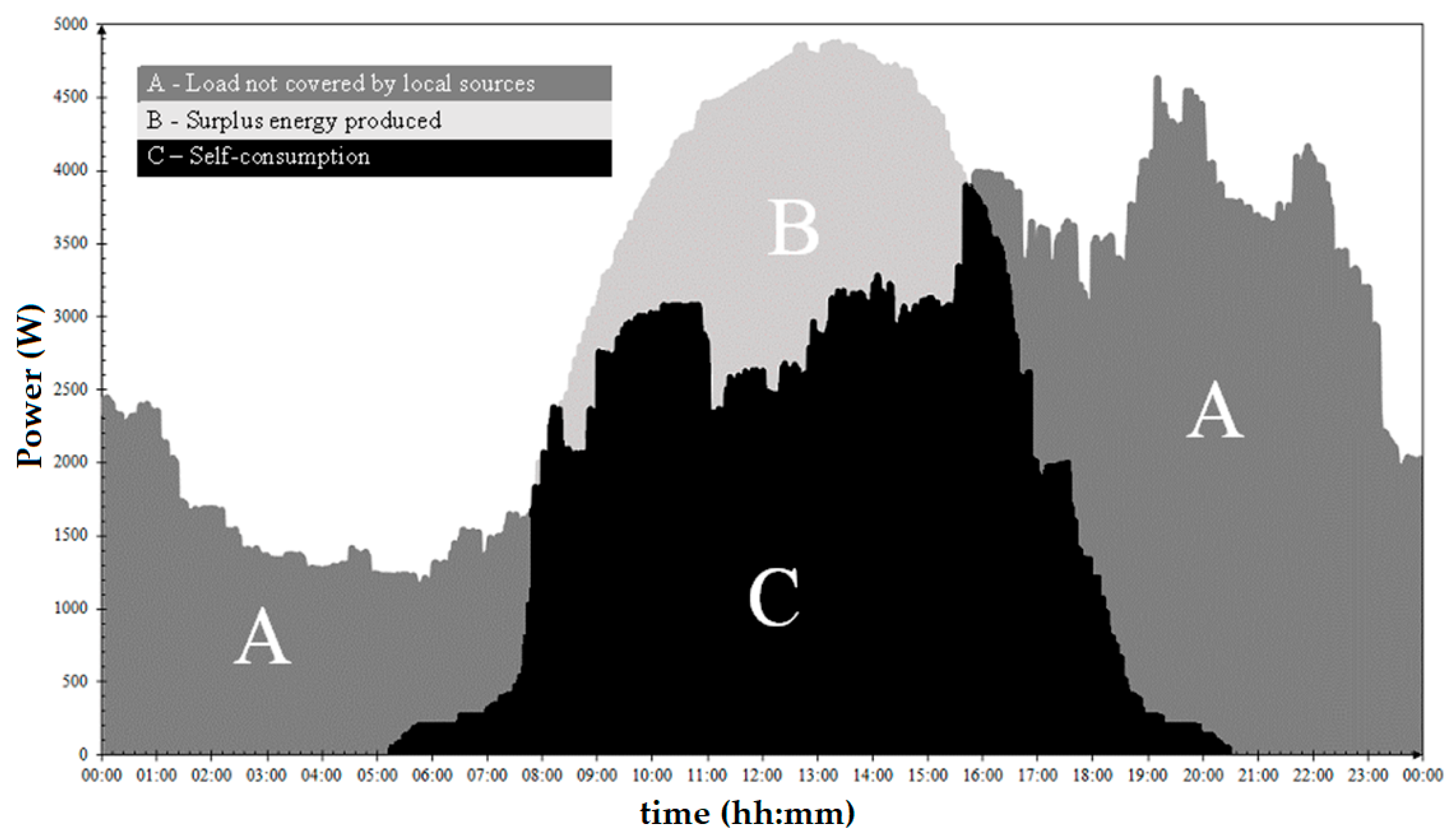

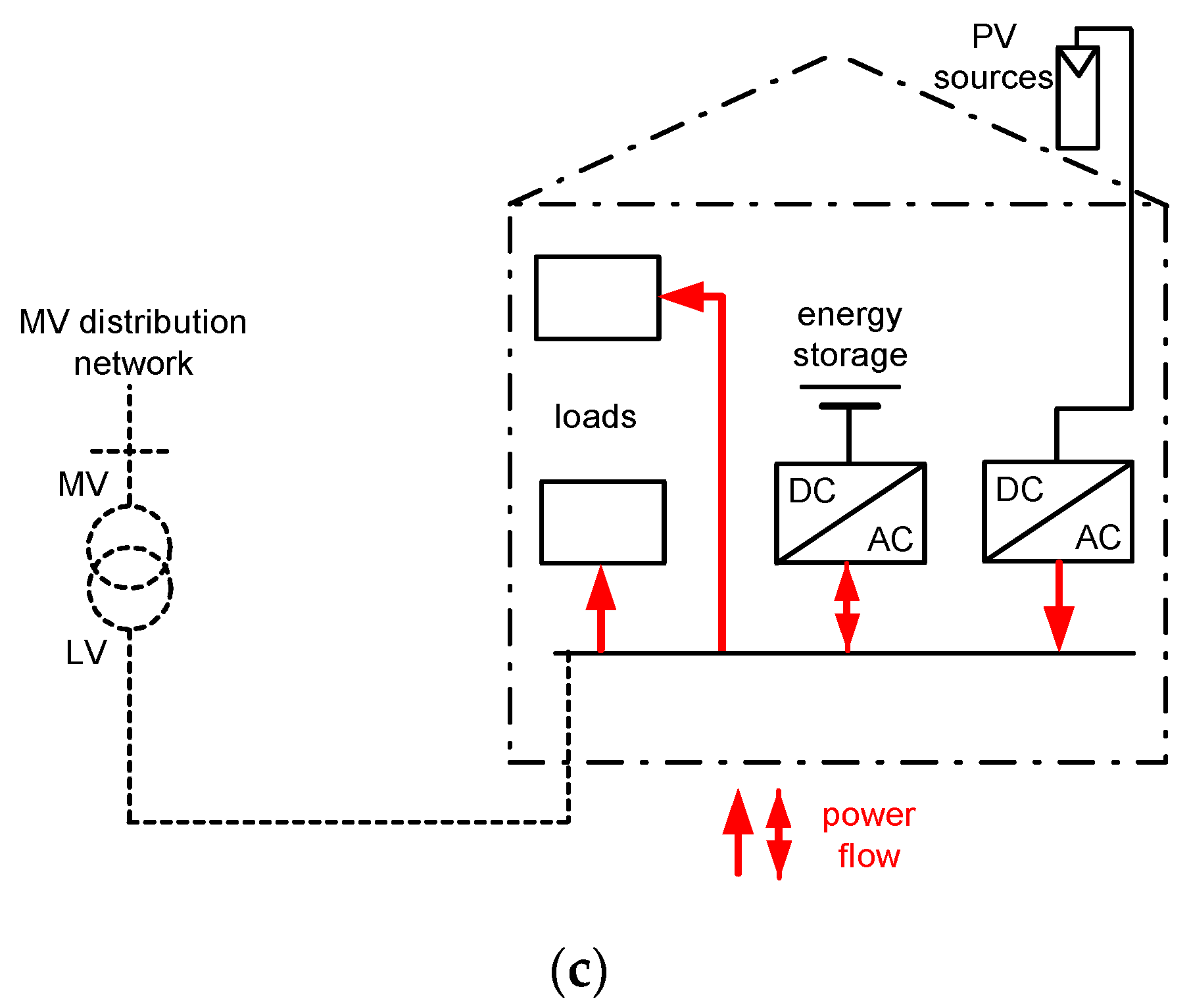
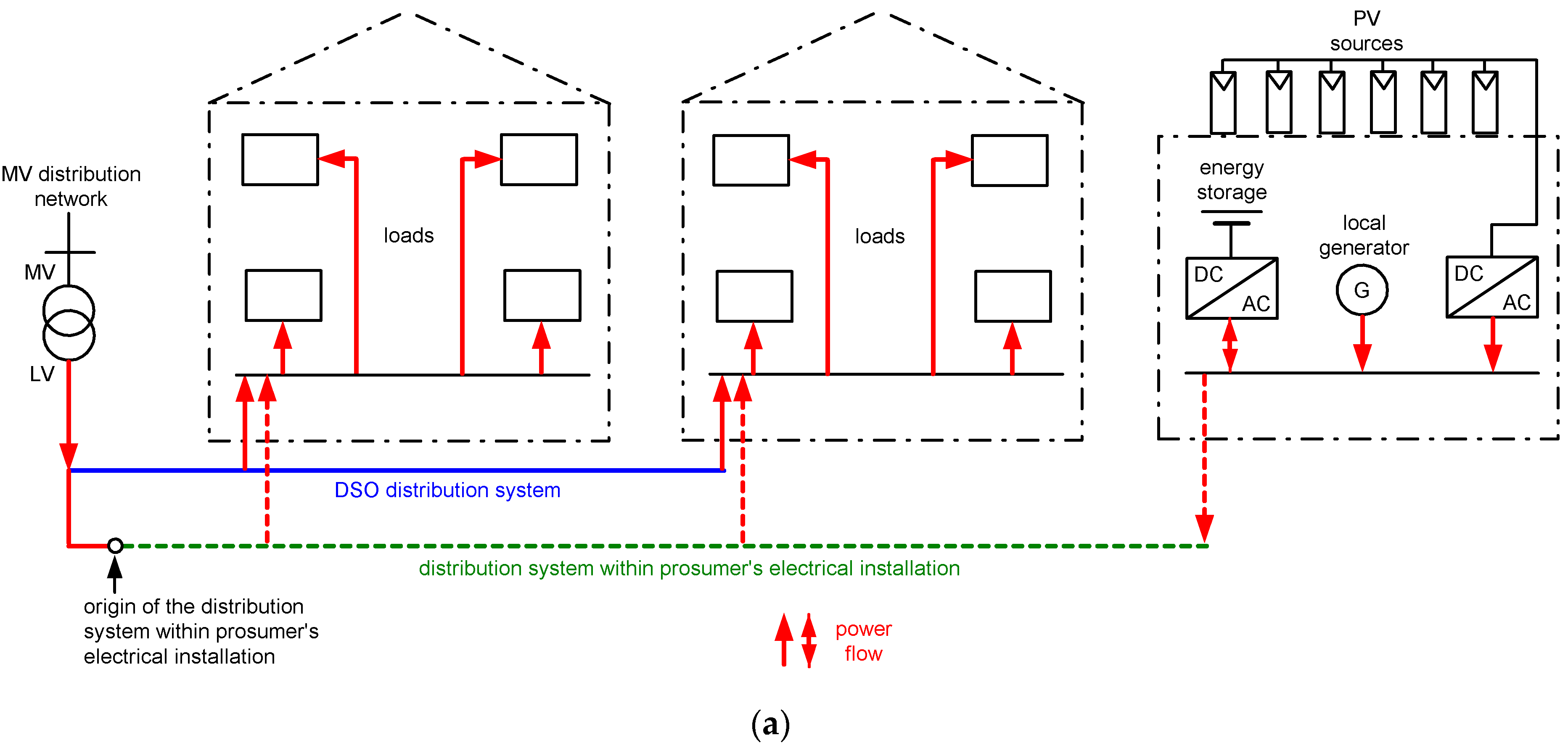
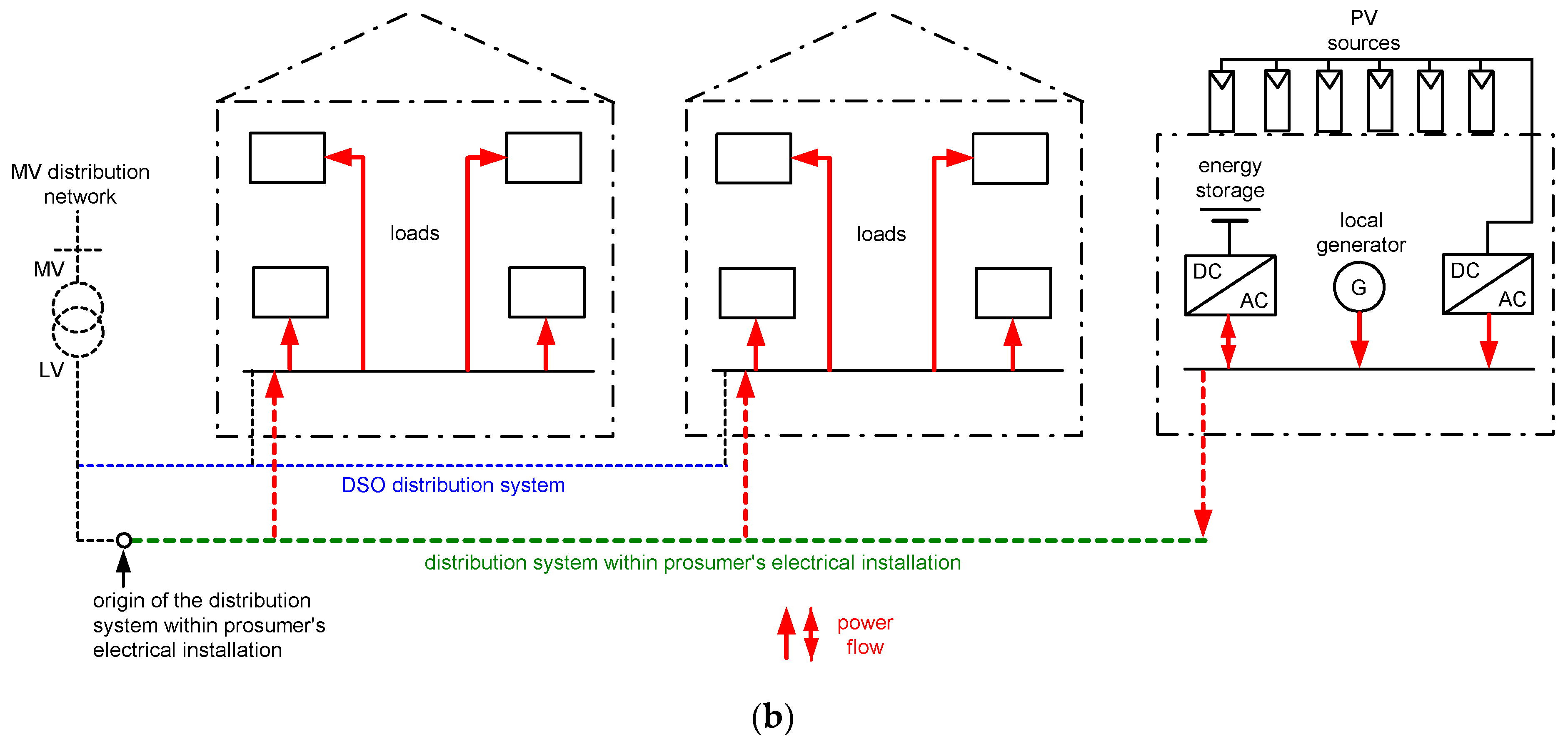
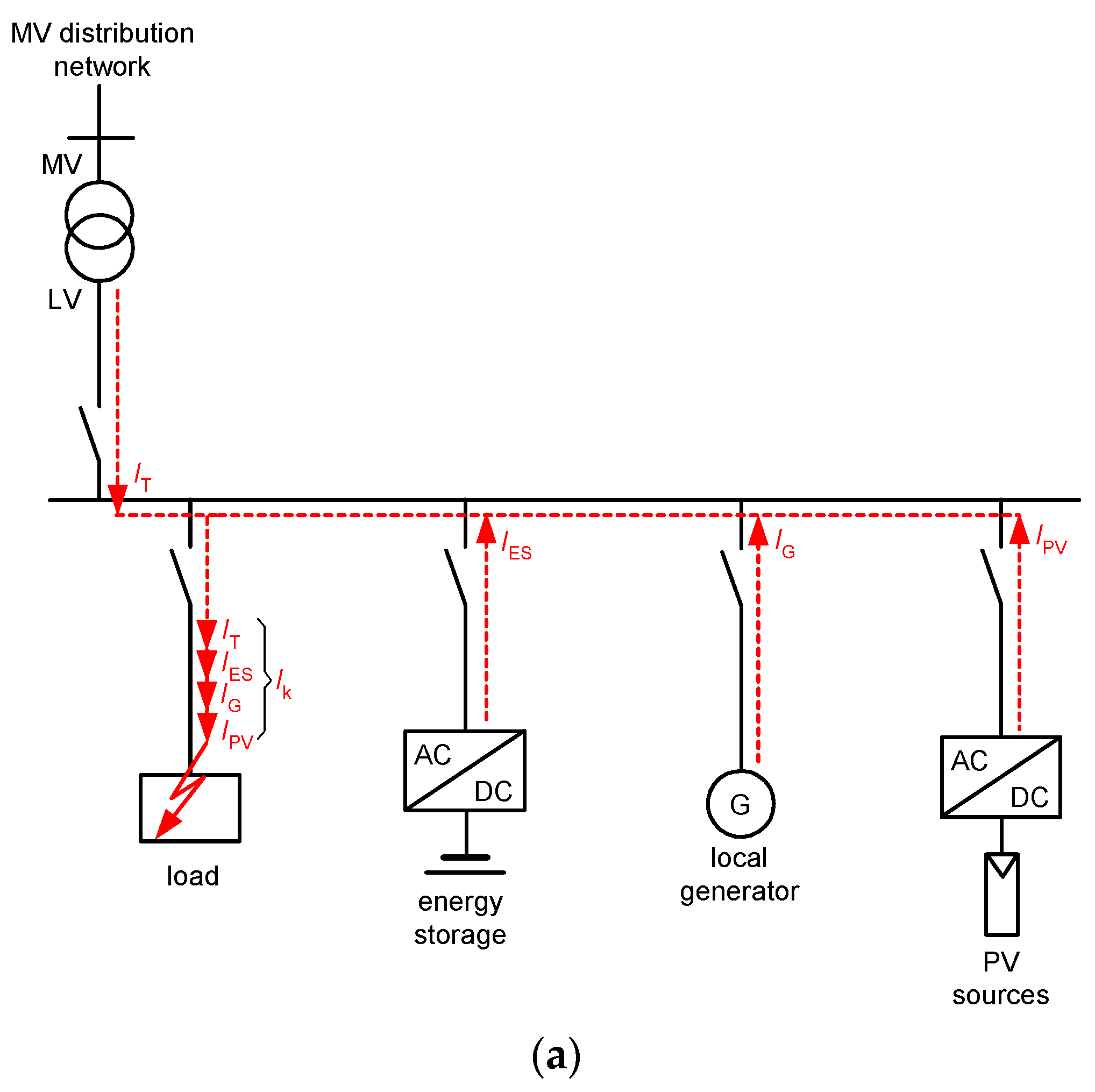
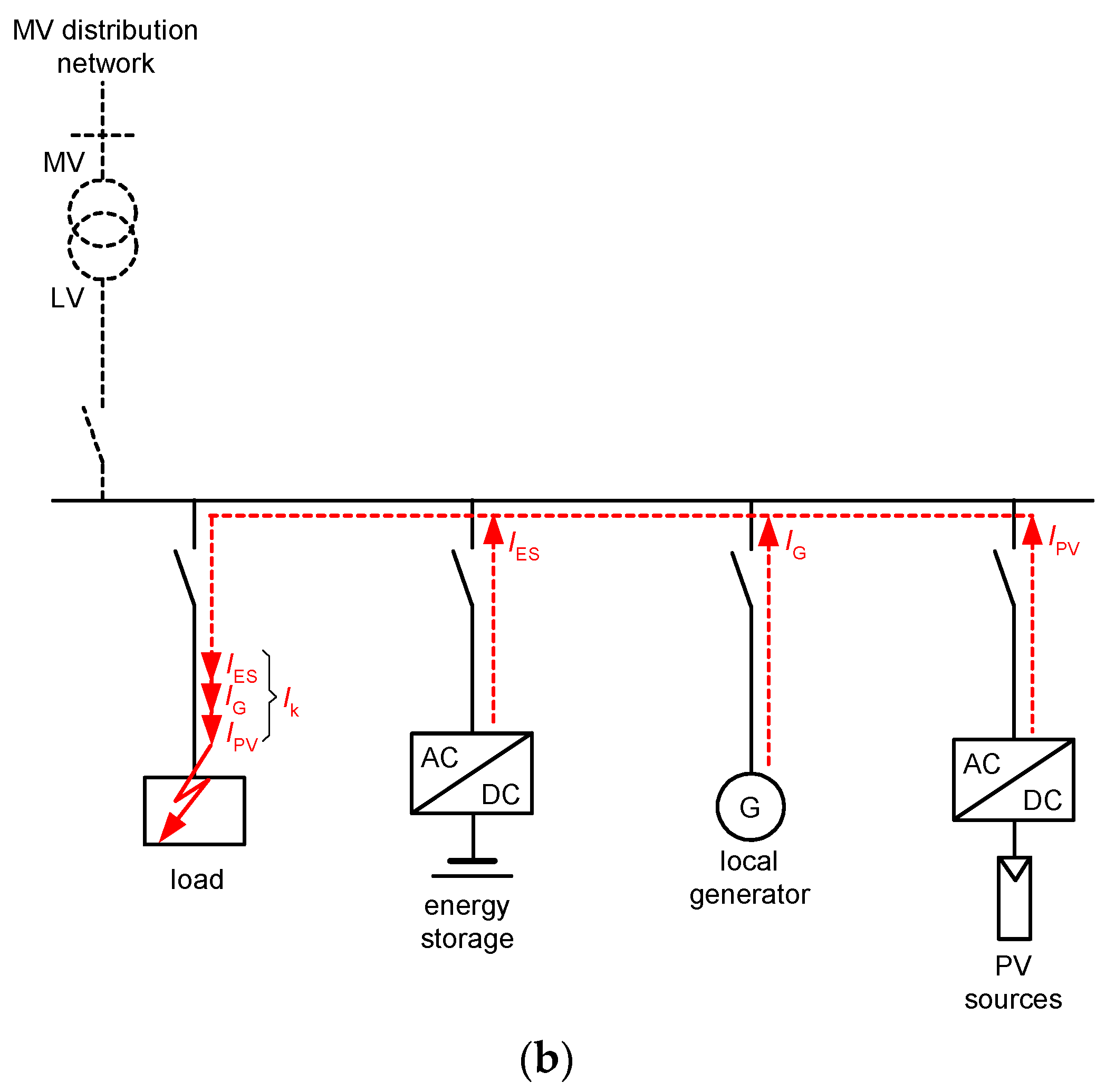
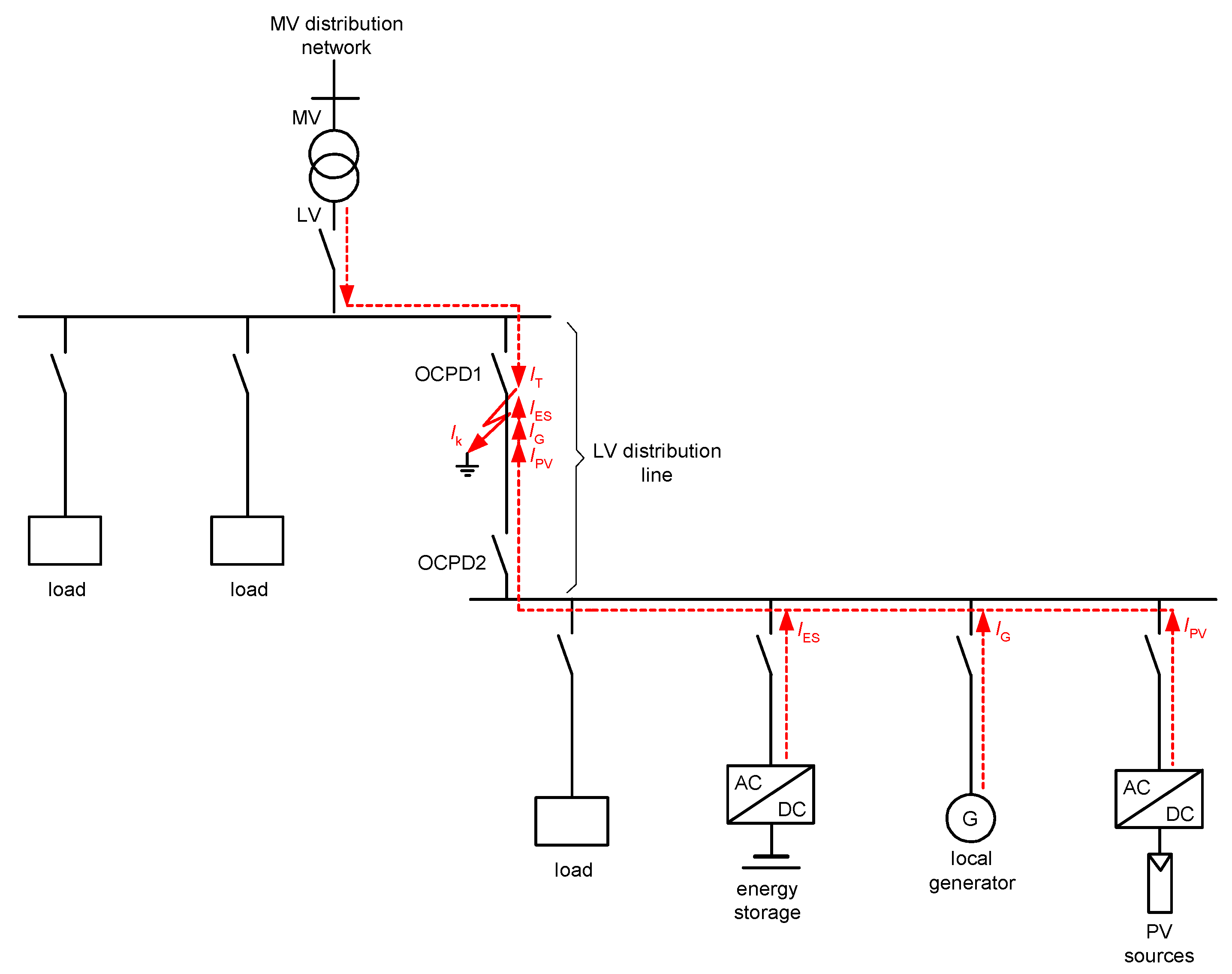

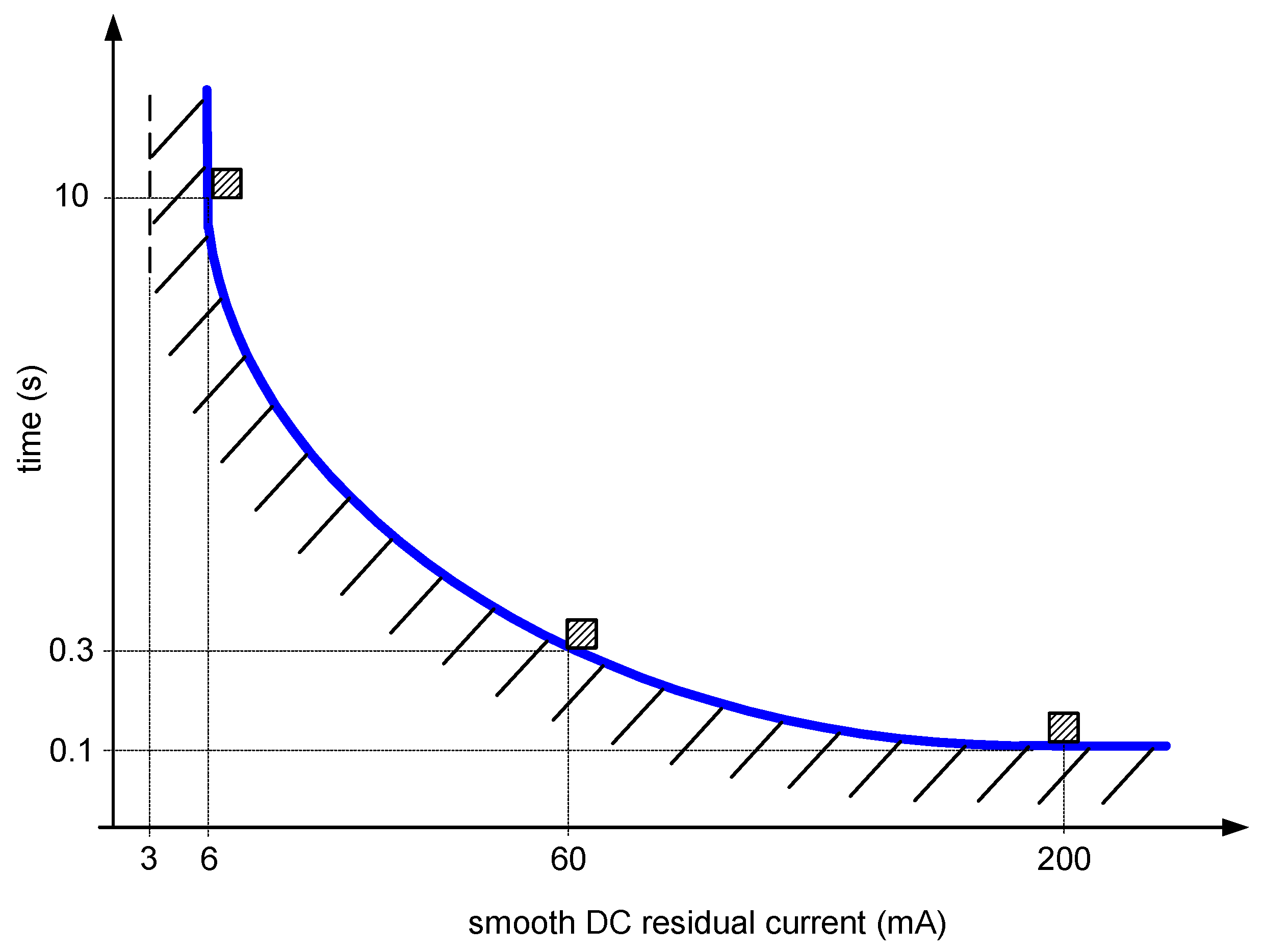

| References | Energy Sources | Type of Solution | Goals Achieved |
|---|---|---|---|
| [30,31,33,74,75,76,77,78,79] | PV + ES | Single-family or public buildings; pilot or simulation solutions | Improvement in electricity quality parameters, increase in self-sufficiency in each case to over 50%, balance assurance, and scalability |
| [27] | PV + ES + Heat pump | Single-family house | Increase in self-sufficiency |
| [78] | PV + ES + Wind turbine | A pilot system in Algeria | Increase in self-sufficiency to over 80% |
| [82,83,84,85,86] | PV + HESS | Pilot or simulation solutions | Increase in energy self-sufficiency, increasing storage durability and reliability |
| [92,93,94,95] | PV + ES + Fuel cell | Pilot building in Slovenia; simulation studies | Increase in self-sufficiency to over 90% |
| [96,97,98,99,100] | PV + ES + Biomass | Pilot or simulation solutions | Use of waste and agricultural products, increase in self-sufficiency and increase in the flexibility of the system operation |
| [101] | PV + ES + Biomass + Solar collectors | Simulation studies in Seville; use of RES for transport and heat production | Increase in self-sufficiency, avoiding seasonal heat storage |
| [102,103] | PV + Thermal energy storage | Energy communities with joint heat storage; pilot and simulation studies | Increase in self-sufficiency, reduction in costs, and shortening of the payback time |
| References | Country and Area | Type of Solution |
|---|---|---|
| [104,105,106] | Slovenia, Luče area | 9 photovoltaic power plants, 5 household energy storage facilities, 1 municipal energy storage, EV chargers, and energy management system based on predictive models and machine learning |
| [23] | Austria, region of 21,000 inhabitants | Simulation studies for PV, and agricultural and forest biomass; micro-cogeneration |
| [107,108,109] | 7 European countries, “Smart Urban Isle” project | Development of locally balanced urban energy island systems, development of a 5-element algorithm for creating locally balanced systems, use of heat pumps, heat storage, DSM/DSR, and energy storage |
| RCD Type | Required Tripping on Residual Current Waveform |
|---|---|
| AC |
|
| A |
|
| F |
|
| B |
|
| B+ |
|
| RDC-DD Type | Properties |
|---|---|
| RDC-MD |
|
| RDC-PD |
|
Disclaimer/Publisher’s Note: The statements, opinions and data contained in all publications are solely those of the individual author(s) and contributor(s) and not of MDPI and/or the editor(s). MDPI and/or the editor(s) disclaim responsibility for any injury to people or property resulting from any ideas, methods, instructions or products referred to in the content. |
© 2023 by the authors. Licensee MDPI, Basel, Switzerland. This article is an open access article distributed under the terms and conditions of the Creative Commons Attribution (CC BY) license (https://creativecommons.org/licenses/by/4.0/).
Share and Cite
Mazur, Ł.; Cieślik, S.; Czapp, S. Trends in Locally Balanced Energy Systems without the Use of Fossil Fuels: A Review. Energies 2023, 16, 4551. https://doi.org/10.3390/en16124551
Mazur Ł, Cieślik S, Czapp S. Trends in Locally Balanced Energy Systems without the Use of Fossil Fuels: A Review. Energies. 2023; 16(12):4551. https://doi.org/10.3390/en16124551
Chicago/Turabian StyleMazur, Łukasz, Sławomir Cieślik, and Stanislaw Czapp. 2023. "Trends in Locally Balanced Energy Systems without the Use of Fossil Fuels: A Review" Energies 16, no. 12: 4551. https://doi.org/10.3390/en16124551
APA StyleMazur, Ł., Cieślik, S., & Czapp, S. (2023). Trends in Locally Balanced Energy Systems without the Use of Fossil Fuels: A Review. Energies, 16(12), 4551. https://doi.org/10.3390/en16124551







